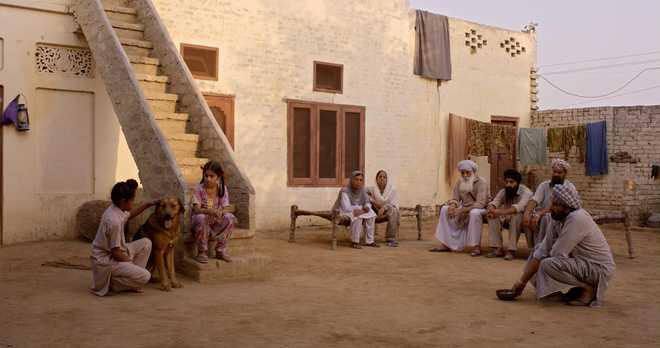
In Gurvinder Singh’s Chauthi Koot, the house with the white staircase was zeroed in after he and his team looked at more than 100 houses
Shardul Bhardwaj
A physical space seems to be the fundamental building block in filmmaking. It is the embodiment of the real and the cinematic image. It is this physical space which is instrumental in building that elusive connection between human perception and truth. A cinematic space is born when it comes onscreen and has a memory life once it is not there on screen.
A telling example of this is the opening scene of Gangs of Wasseypur 2 where Faizal is shown walking into the narrow alley which leads to Sardar Khan’s house and it is intercut with scenes from Danish’s funeral. The alley, the milieu, the people and a certain energy have been well-established. The space around Sardar Khan’s house was already born and brought to fruition by Anurag Kashyap in the first installment of Gangs of Wasseypur. It’s like the space of the alley and Sardar Khan’s house had gone on a brief journey and have come back where all his good friends (the audience) were waiting to take up the conversation from where they had left.
Often due to the pressures of commercial viability, popular Hindi films conform to the ideals of restaurant ambience so that the product becomes easily consumable. Some such examples are Bajrangi Bhaijaan and M.S. Dhoni: The Untold Story. Dhoni’s house is shown mostly as the living room where the parents are sitting and watching the match. There is no interiority to the space. Neither do the characters seem to hold forth in the space. It could have been any middle class family and middle-aged husband and wife in that middle-class house. What makes a house distinctive is its inhabitants with their various histories, experiences and hopes. In M.S. Dhoni (2016), the film flattens it all out to give us an easily consumable chocolate bar where everything tastes the same and different layers have the semblance of a difference but there’s no real difference.
Another film from a year before Chauthi Koot, a Punjabi feature film directed by Gurvinder Singh, seems to offer us a completely different perspective of the space called house. Gurvinder seems to be a master in shooting spaces. Through a careful selection of spaces, he can bring out stories of people through spaces and spaces through people. In Chauthi Koot, the house shown has a white staircase, which seems to be the centre of the house. At the foot of the staircase is Tommy, the dog, who seems to be the point of contention in the terrorised and militarised Punjab of the 1980s. This staircase is both meant as a way to go upstairs and is also the only way to physically reach younger members of the family.
According to Gurvinder, he and his team looked at more than 100 houses before zeroing in on this. In this process, the script informs the choice of space and the space then also organically leads to additions and subtractions in the script. There seems to exist a simplistic synergy between the space and characters.
One such simplistic synergy is pointed out by the great Russian director Andrei Tarkovsky in Akira Kurosawa’s Throne of Blood, an adaptation of Shakespeare’s Macbeth. He says, “In the scene where Macbeth is lost in the forest, a lesser director would have the actors stumbling around in the fog in search of the right direction, bumping into trees. Kurosawa, however, finds a place with a distinctive, memorable tree. The horsemen go round three times in a circle, so that the sight of the tree eventually makes it clear that they long ago lost their way”.
It is inarguably an ingenious and simple yet complex moment completely brought upon by great understanding of space.
This understanding is guided by the fact that the continuous space, seen by the audience, is initially just fragments when it is being shot. The meaning lies in bringing together of the fragments. Good films are able to cement those fragments in relation to the story, characters and the moment. Leading to an organic and alive space within a film, this space does not just exist as an embellishment or a necessity to package a product.



























